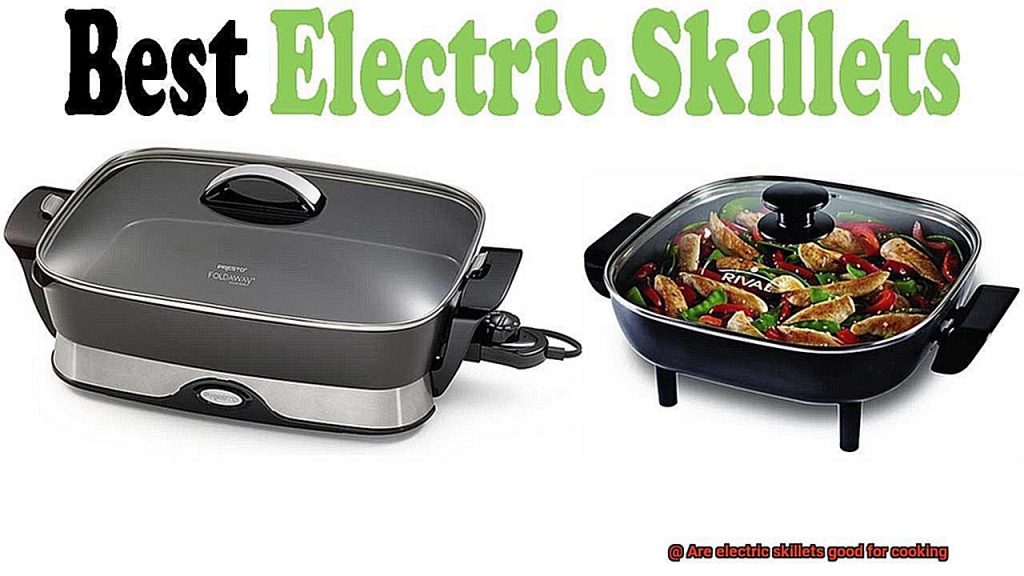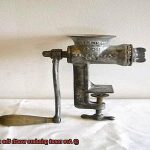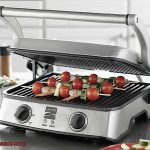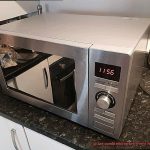Are electric skillets worth it? It’s a question that has sparked many heated debates among kitchen enthusiasts. Some swear by the convenience and versatility of electric skillets, while others remain loyal to the traditional stovetop method. With so many conflicting opinions, it can be tough to decide whether investing in an electric skillet is truly worth it.
If you’re someone who loves to cook or enjoys experimenting with new recipes, then an electric skillet could be the perfect addition to your kitchen arsenal. Boasting a wide range of temperature settings, these nifty gadgets make cooking everything from fluffy pancakes to sizzling stir-fries an absolute breeze. Plus, they eliminate the need for a stove, making them ideal for those with limited counter space or small kitchens.
However, like any kitchen appliance, electric skillets do come with their own set of drawbacks. They can be bulky and challenging to store, and some models may struggle to reach high temperatures required for certain dishes. Additionally, they may not offer the same level of precision and control as a stovetop skillet – which could be a dealbreaker for some home cooks.
In this blog post, we’ll take a closer look at the pros and cons of electric skillets and help you determine whether they’re worth investing in for your kitchen. So whether you’re still on the fence about purchasing one or simply curious about this handy gadget – keep reading. We’ll uncover all there is to know about whether electric skillets are truly worth it.
Contents
Advantages of Electric Skillets
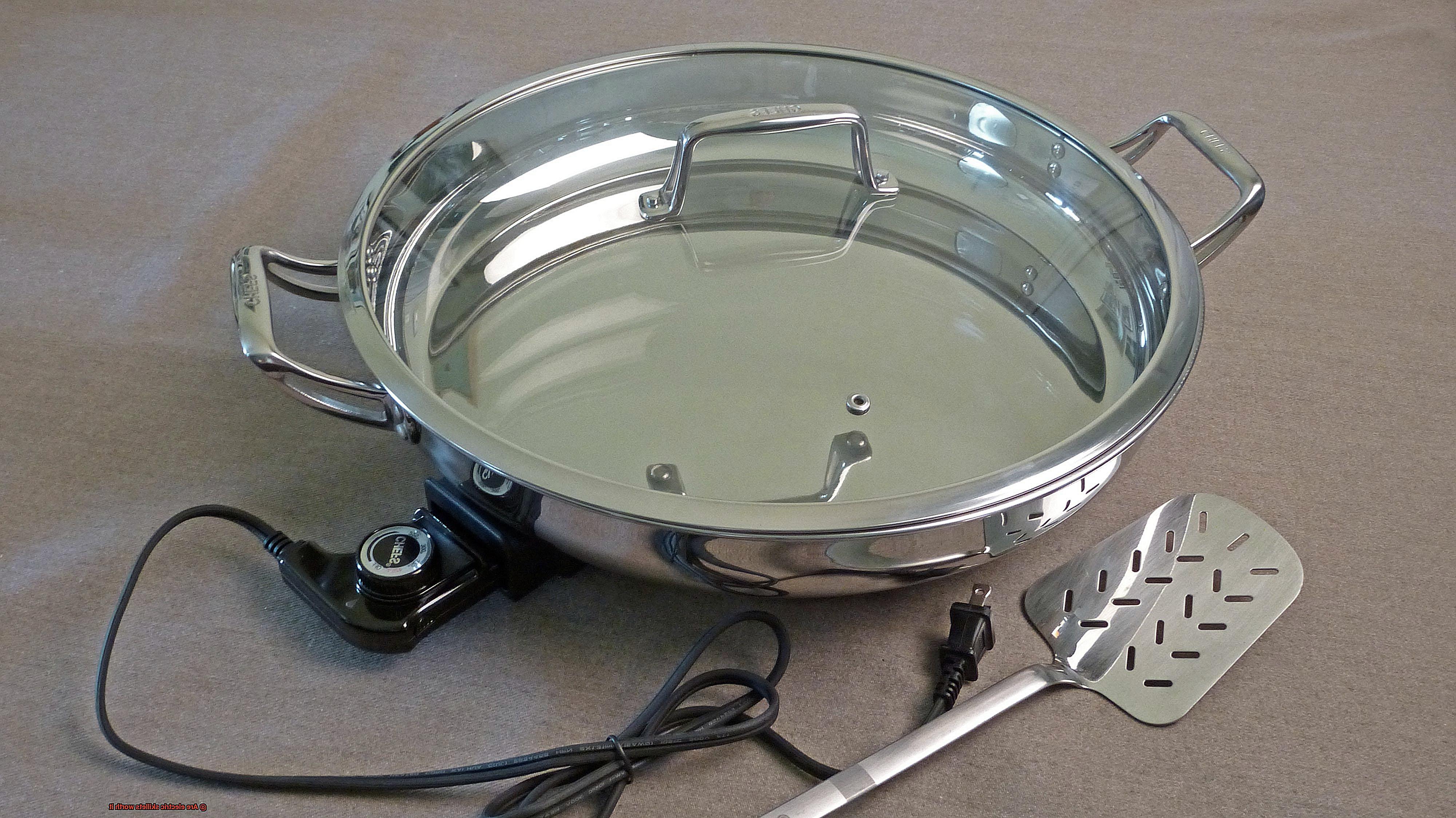
Electric skillets may be the answer to your culinary woes. With their versatile capabilities, temperature control, convenience, energy efficiency, and easy-to-clean features, electric skillets are becoming an indispensable tool in many households.
One of the most significant advantages of electric skillets is their versatility. These appliances can perform a wide range of cooking tasks, from frying and sautéing to grilling and baking. Whether you are looking to whip up a quick breakfast of pancakes and bacon or create a hearty stew or casserole, electric skillets can handle it all.
Temperature control is another significant advantage of electric skillets. With the ability to adjust the heat to the desired level, you can cook your food evenly without the risk of burning. This feature ensures that your meals come out perfectly cooked every time.
Electric skillets are also incredibly convenient to use. They can be used anywhere there is an electrical outlet, making them ideal for outdoor cooking or for use in small kitchens with limited space. Plus, they heat up quickly and maintain a consistent temperature, saving you time and energy.
In addition to their convenience, electric skillets are energy-efficient and inexpensive to operate. Compared to traditional stovetops, they require only a small amount of electricity to function correctly. Therefore, you can save money on your electricity bill while still enjoying delicious home-cooked meals.
Finally, cleaning up after cooking with an electric skillet is a breeze. With their non-stick surfaces, food doesn’t stick to the pan, making cleanup fast and easy. All you need is a damp cloth or sponge to wipe away any residual food particles.
Disadvantages of Electric Skillets
If you’re considering purchasing an electric skillet for your kitchen, it’s important to know about their potential drawbacks. While they offer convenience and energy efficiency, there are limitations that may not make them the best fit for every home cook.
One of the major disadvantages of electric skillets is their limited temperature range. Unlike gas or traditional stovetops, which allow for precise temperature control, electric skillets typically only have a few preset heat settings. This can make it difficult to achieve the exact temperature needed for certain types of cooking, such as searing or frying. So if you’re someone who loves to experiment with different cooking techniques and requires more control over your heat source, an electric skillet may not be the best option for you.
Another disadvantage of electric skillets is their size and shape. While they can be convenient for cooking smaller meals, they may not be suitable for larger dishes or cooking for a crowd. Additionally, the shape of electric skillets can limit the types of dishes that can be prepared in them. Their shallow depth may not accommodate foods that require more liquid or deeper pans. So if you’re someone who enjoys cooking bigger meals for family gatherings or parties, an electric skillet may not be the most practical choice.
Cleaning an electric skillet can also be a bit of a hassle. Their electrical components mean they cannot be submerged in water like traditional cookware and must be wiped down with a damp cloth or sponge. This can make them more difficult to clean than other types of cookware. So if ease of cleaning is a priority for you, an electric skillet may not be the best option.
Lastly, electric skillets may not be as durable as other types of cookware. With frequent use, the non-stick coating on the surface may begin to wear off and the electrical components may become less reliable over time. This means that electric skillets may need to be replaced more frequently than other types of cookware. So if you’re looking for a long-lasting investment in your kitchen, an electric skillet may not be the most economical choice.
Factors to Consider When Choosing an Electric Skillet
With so many options on the market, it can be overwhelming to choose the right one. But don’t fret. As an expert in electric skillets, I’m here to help you navigate the key factors to consider before making your purchase.
First and foremost, size matters. Determine what size skillet will be most suitable for your needs. If you’re cooking for a large family or hosting dinner parties, a larger skillet would be ideal. However, if you’re cooking for one or two people, a smaller skillet would suffice and take up less space in your kitchen.
Another important factor is the material of the skillet. Non-stick coated aluminum skillets are usually less expensive but may not be as durable as stainless steel ones. Stainless steel skillets are more durable and can handle higher temperatures, but they can be more costly. Consider your budget and how often you plan to use the skillet before deciding on which material is best for you.
The temperature range of the electric skillet is also worth considering. Some skillets have a wider temperature range than others, which can be useful if you want to use it for different types of cooking. Additionally, some skillets come with a temperature control feature that allows you to adjust the heat precisely.
The depth of the skillet is another often-overlooked factor that can make a big difference in your cooking experience. A deeper skillet can hold more food and liquids, making it ideal for dishes such as stews and sauces. On the other hand, a shallower skillet may be better suited for dishes such as pancakes and omelets.
Lastly, let’s talk about cleaning. Nobody enjoys cleaning up after cooking, but some skillets are easier to clean than others. Non-stick coated skillets are generally easier to clean than stainless steel ones. Additionally, some skillets have removable parts that can be washed in the dishwasher, making cleaning even more effortless.
Benefits of Using an Electric Skillet
If you answered yes to either of these questions, then it’s time to invest in an electric skillet. As an expert in the field, I can attest that electric skillets offer a plethora of benefits that make them a must-have addition to any kitchen.
One of the most significant advantages of using an electric skillet is its versatility. You can use it for frying, grilling, sautéing, roasting, baking – you name it. Say goodbye to cluttered stovetops and hello to an all-in-one cooking solution.
Electric skillets also offer consistent heat distribution, unlike traditional skillets that have hot spots causing uneven cooking. With even heat distribution across the entire surface, your food will cook perfectly every time.
Cleaning up after a meal can be a hassle, but with nonstick surfaces, electric skillets make it effortless. They prevent food from sticking to the cooking surface, making cleanup quick and easy. And if you’re short on time or simply don’t want to wash by hand, most electric skillets are dishwasher safe.
But the benefits don’t stop there. Electric skillets are also a time and energy-saving solution. They heat up much faster than traditional stovetop skillets and use less energy since they only heat up the cooking surface. And because they’re portable, you can take them anywhere with an electrical outlet – perfect for outdoor cooking or small kitchens with limited space.
Types of Electric Skillets Available
It might be time to switch things up with an electric skillet. These versatile appliances are becoming increasingly popular among home cooks, offering convenience and flexibility in the kitchen. However, with so many types of electric skillets available, it can be difficult to choose the right one for your needs. In this article, we’ll dive into the different types of electric skillets on the market and their unique features.
First on the list is the non-stick electric skillet. These skillets are perfect for cooking delicate foods like eggs and pancakes that require a non-stick surface. They’re a breeze to clean and require less oil than traditional stovetop cooking. However, they may not be suitable for high-heat cooking or searing meats, so keep that in mind when making your selection.
If durability is a top priority for you, consider a stainless steel electric skillet. These skillets heat up quickly and evenly, making them ideal for searing meats and stir-frying. Plus, their sleek appearance adds a touch of sophistication to any kitchen. However, without a non-stick surface, they can be more challenging to clean and food may stick to the surface.
For those concerned about harmful chemicals in traditional non-stick coatings, ceramic electric skillets offer a safe alternative. With a ceramic coating that provides a non-stick surface, these skillets are perfect for cooking delicate foods like fish or vegetables at high temperatures. They also distribute heat evenly, making them a great choice for slow-cooking stews and casseroles.
Last but not least, cast iron electric skillets offer a nod to traditional cooking methods. These skillets retain heat well, allowing for even cooking and browning of meats. They’re also highly durable but require more maintenance compared to other types of electric skillets. If you’re willing to put in the effort, a cast iron skillet can last for generations.
Tips for Cooking with an Electric Skillet
Cooking with an electric skillet is a great way to save time and energy in the kitchen. However, to make the most out of your appliance, there are a few things you need to keep in mind. Here are five tips for cooking with an electric skillet:
Preheat the Skillet
Preheating your electric skillet is an essential step to ensure that your food cooks evenly and doesn’t stick to the surface. Set your skillet to the desired temperature and let it heat up for a few minutes before adding any ingredients.
Use the Right Temperature
Most electric skillets come with temperature controls, so it’s crucial to use the right setting for each recipe. High temperatures are ideal for searing and browning, while lower temperatures are perfect for slow-cooking.
If you’re not sure what temperature to use, start with a lower temperature and increase it gradually as needed.
Don’t Overcrowd the Skillet
Overcrowding your electric skillet can lead to uneven cooking and sticking. Make sure there’s enough space between each item so that they cook evenly. If you have a lot of food to cook, consider cooking it in batches instead of trying to fit it all in at once.
Use Non-Stick Spray or Oil
To prevent sticking, use non-stick spray or oil before adding any ingredients to the skillet. This will make sure that your food comes out easily without sticking to the surface.
Clean the Skillet Properly
After you’re done cooking, clean your electric skillet properly to prevent rusting and ensure longevity. Rinse it with warm soapy water and dry it thoroughly. Some skillets come with removable parts that can be washed in the dishwasher.
Cleaning and Maintenance Tips for an Electric Skillet
Electric skillets are a must-have appliance in any kitchen. But, just like any other appliance, it requires regular cleaning and maintenance to ensure it lasts for years to come. Here are five reasons why you should prioritize cleaning and maintaining your electric skillet:
Prolongs lifespan
You have invested money in purchasing your electric skillet, so it makes sense to want it to last as long as possible. By cleaning and maintaining it regularly, you can ensure that it stays in top condition and continues serving you for years.
Promotes optimal performance
A dirty or damaged electric skillet may not function as well as a clean one. Regular cleaning and maintenance can help keep the non-stick surface smooth, preventing food from sticking and ensuring even cooking.
Prevents health risks
Grease and food particles can accumulate on the surface of the skillet, posing health risks if left uncleaned. Regular cleaning can prevent bacteria growth and prevent contamination of the food.
Maintains flavor
A dirty electric skillet can affect the taste of your food. The accumulation of old grease or food particles may lead to an unpleasant taste or odor on your food. Regular cleaning ensures that your food tastes fresh every time.
Saves money
By taking proper care of your electric skillet, you can avoid having to replace it sooner than necessary. Regular maintenance can prevent damage and save you money in the long run.
Alternatives to an Electric Skillet
Perhaps you want to shake things up a bit, or maybe investing in an electric skillet just isn’t in the cards for you right now. Fear not, because there are plenty of alternatives that can achieve similar results and add some variety to your cooking routine.
One of the most versatile options is a stovetop skillet or frying pan. These kitchen staples come in a range of sizes and materials, such as cast iron or stainless steel, and can be used on gas or electric stovetops. They offer precise temperature control and can be used for sautéing, searing, and frying, making them perfect for a wide range of dishes.
If you’re a fan of breakfast foods, a griddle might be just what you need. Available in both electric and stovetop versions, griddles feature flat cooking surfaces that are perfect for pancakes, eggs, bacon, and other similar items. Made from durable materials like cast iron or nonstick materials, griddles are easy to clean and last a long time.
Outdoor cooking enthusiasts can turn to the classic grill as an alternative to an electric skillet. Whether you prefer the smoky flavor of charcoal or the quick convenience of gas, grills are perfect for cooking meats, vegetables, and even pizzas. Plus, there’s something about cooking outdoors that just makes everything taste better.
Finally, slow cookers or crockpots offer a convenient alternative to an electric skillet. These appliances are perfect for cooking stews, soups, and roasts. Simply set it and forget it – the slow cooker will do all the work while you go about your day.
While electric skillets may offer convenience and versatility, it’s always good to have some variety in your cooking routine. With these alternatives at your disposal, you can achieve similar results using different methods. It all comes down to personal preference and what works best for your cooking needs.
kqA4itLG_lg” >
Conclusion
In the end, whether or not electric skillets are worth it is a matter of personal preference and cooking needs. These versatile appliances offer numerous benefits, including precise temperature control, energy efficiency, and easy-to-clean features. However, they do have some drawbacks such as limited temperature range and size limitations.
When selecting an electric skillet, it’s important to consider factors such as size, material, depth, and ease of cleaning. Additionally, there are other kitchen tools that can achieve similar results such as stovetop skillets or frying pans for those who prefer traditional cooking methods. Griddles are perfect for breakfast food enthusiasts while outdoor grills cater to outdoor cooking lovers. Slow cookers also provide a set-it-and-forget-it option for busy individuals.
Remember to prioritize regular cleaning and maintenance regardless of your choice of cooking appliance or method to ensure optimal performance and prolong its lifespan.

